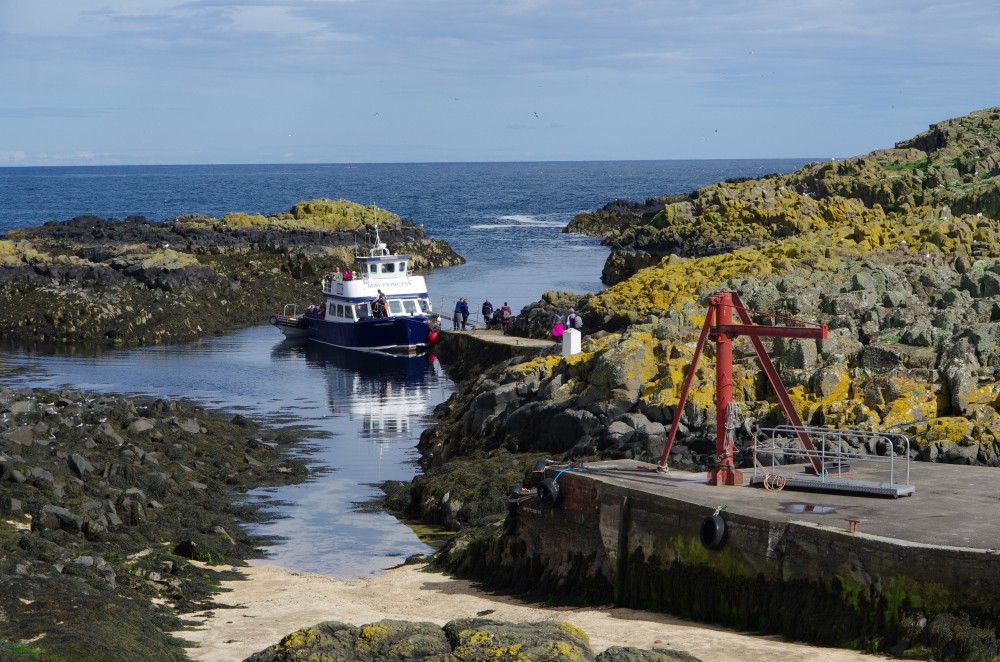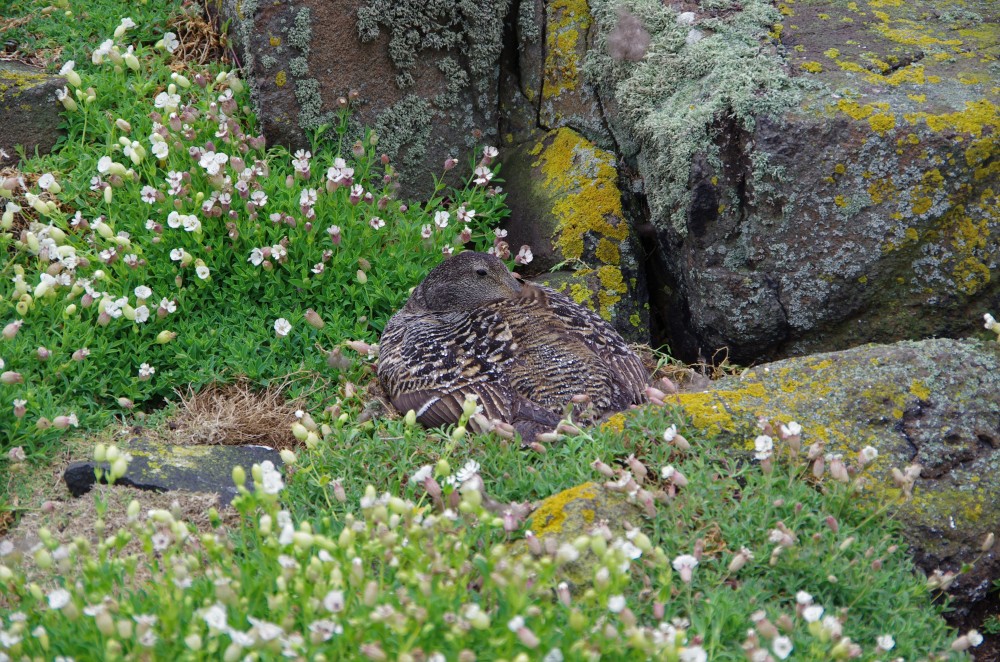It seemed appropriate to visit the Isle of May in May. Situated in the outer reaches of the Firth of Forth – practically in the North Sea – this tiny island is home to a huge number of sea birds including puffins. Never having seen a puffin, despite them nesting in many places around Scotland, I sailed on the May Princess from the picturesque port of Anstruther in Fife to seek out these wee black and white birds.

The Firth of Forth separates the Lothians and Edinburgh with the Kingdom of Fife, and is spanned by three bridges at Queensferry – two for motor traffic and one for trains. The Isle of May is the furthest east of all the little islands which dot the firth, and, like many of the others, had played an important part in history in terms of guiding ships, providing safety, and as a lookout for ‘the enemy’ (whoever that might have been at the time).
There were around 100 of us on the boat, with 3 of a friendly, helpful crew, which arrived to augment some dozen people staying there as researchers and volunteers. We had a short talk first about the importance of staying on the paths, as the puffins nest in shallow burrows and it would be quite easy to put your foot through one if you walked across it. Many of these paths have quaint names – Prior’s Walk, Pipe Loan, Haven Road. The small visitor centre told us what to look out for at this time of year, and had a nice display of photos of birds and their descriptions.
I had seen my first puffin on the trip over – not far out of Anstruther, one was swimming gamely in the swell. More appeared here and there, including one, just before we landed, who appeared to be running on top of the water! I had been feeling a bit travel sick on the way over so didn’t join in the frenzy of enormous lenses jostling to snap the first sights of these birds, and some seals lazing on the rocks beneath the tall black cliffs.

On land, I felt fine, and with a friend of mine who was volunteering there for the week for our guide, we set off to look for puffins. Or so I thought.
There is so much more to the Isle of May than puffins though. It may only be 1.8km long and less than half a kilometre wide, but it is home to a multitude of sea birds, rabbits and seals, as well as several unexpected buildings. Clouds of white sea campion covered the places where the arctic terns were nesting, noisily protesting at us, at each other, at the rabbits… at anything in fact which could possibly be a threat to their nests. These beautiful little birds fly enormous distances, around 70,900km annually, nesting between every one and three years – and I was travel sick from the 80 mile car journey and 5 mile sea crossing.
We made our way to the top of the black cliffs we had seen from the boat, where the birds – kittiwakes, guillemots, razorbills and fulmars – all nestled and jostled on shallow sloping ledges. The noise was like an orchestra, with deep notes from timpani and double bass, and rising notes through the brass section, strings and woodwind. In places, guillemots stood face to the cliff in a row like a group of men using a urinal.

In other places, birds nested at improbable angles, an egg or more pressed gently between themselves and the rock. One even had her wing held out at an awkward angle to prevent the egg from slipping away.

The best nesting areas are at the top of the cliff – the birds lower down were speckled in white guano from above. Some birds had made nests out of grass or rope or even pieces of plastic – anything washed or blown ashore. Just in the past week, one had been found with a hedgehog in its nest… There are no hedgehogs on the island, so that one is a bit of a mystery.
We walked along Lady’s Loan to passed the first of some impressive buildings – the south fog horn, no longer in commission, but linked to the north fog horn by a long metal pipe whose plates and rivets still looked strong. Compressed air sounded each of the horns 67.5 seconds apart. Decommissioned in 1989, these are kept painted and still look impressive.
To avoid more nesting terns, we doubled back towards the visitors’ centre, and passed the ruins of a church, founded in the 9th century, although there is evidence of habitation on the island since the bronze age. An excavation in the 1990s revealed burial sites and parts of other buildings – boards inside the church tell what little is known of the history, although it was – of course – plundered by Vikings as recorded in the Orkneyinga Saga.

We headed up past a particularly vicious tern, guarding her nest. Thankfully my friend is very tall, so she swooped and dived on him, leaving his leather hat with scars. We were advised to wear a hat or hold our hand high to distract the bird, but not to try to hit it as it is such a delicate bird this could be fatal. But she was only doing what she needed to do – protecting her eggs.
Further up Fluke Street, we saw several eider ducks, sunk low into the ground and foliage, almost invisible. In contrast with the excitable tern, they regarded us calmly and didn’t betray they were even alive by a single movement.

At the end of this path was a loch leading to the sea, where several eider adults, male and female, were swimming with clutches of tiny fluffy ducklings. Almost as soon as these duckling hatch, their mothers start guiding them towards the sea as they want to get them away from predatory gulls on the island. Using safety in numbers, they sail in flotillas out into the wide sea. We had passed one such grouping on our journey over, three adults with a fluffy raft of tiny ducklings, braving the sea to find safety.

We then took Palpitation Brae, a steep but thankfully short walk up to not one but three lighthouses. The first, a square whitewashed building with crenulations. This was Scotland’s very first lighthouse called The Beacon, built in 1635, which used over 400 tonnes of coal annually.

Originally, it stood three stories high, but this obscured the light from the new lighthouse which was built in 1816. This was designed by Robert Stevenson of the famous lighthouse-building family (which also included the very famous author of Dr Jekyll and Mr Hyde, RLS). However, it was saved from complete demolition by the intervention of Sir Walter Scott and the ground floor preserved – it is now used as a bird observatory I think.
The 1816 lighthouse looks like a small castle or stately home, with the light on the top – really nothing like what a traditional lighthouse is ‘supposed’ to look like. There are buildings nearby where the families of the keepers lived, and also walled gardens where they grew fresh vegetables. It’s also a lovely spot for a bit of lunch if the sun is out, and the gardens attract lots of small birds – warblers and a white throat were seen when we were there.

The third lighthouse is behind this, called the Low Light, and constructed in 1843. It is no longer used, but volunteers stay there and have fantastic views across the sea.

So, I went to the Isle of May to see puffins… Did I see many of them? I saw a lot, in fact, particularly on Holyman’s Road, but mainly quite far away, or flying like little spitfires – they go really fast! In May, they are often out to sea gathering sand eels for their mates sitting on the one egg they lay. In June the pufflings begin to hatch, and they all leave in July. So I didn’t get a close view of a puffin – most of my photos are from a zoom lense, and even still they are pretty small and in the distance. But it was lovely to see them zipping about amongst the larger birds, and hearing their weird ‘dinosaur’ croak coming from up the burrows.

So, I will just have to brave the travel sickness again and go back next year, but later – in June – and try to get a little bit closer to the puffins!




Lovely, Ailsa – I love the isle of May too! But I also love the boat so I feel for you!
LikeLike